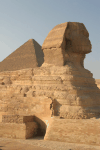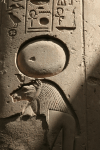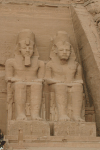
Architecture
Egypt holds one of the most impressive remnants of Ancient Civilizations that I encountered during my travels.
Ancient Egypt was a fascinating culture. It started well before 3200 BCE. Sometime after 3100 BCE, Upper Egypt (the south, what is now Sudan), and Lower Egypt (the north, what is current Egypt) were united by the King Narmer, the first Pharaoh to rule over a united Egypt.
The Early Dynastic Period includes the 1st and 2nd Dynasties (3100 - 2655 BCE). The capital at that time was in Thinis. This period lasted till 2655 BCE.
The next period was the Old Kingdom, which started with the 3rd Dynasty (2727 - 2655 BCE). The second Pharaoh of this Dynasty was Djoser (2709 - 2690 BCE), who built the Step Pyramid. The 4th Dynasty (2655 - 2484 BCE) was the one that built the Great Pyramids of Giza. The royal capital of the Old Kingdom was located at Memphis.
During the 5th and 6th Dynasties (2484 - 2176 BCE) Egypt declined, after having over extended itself with the building of the Great Pyramids. The final blow was a sudden and short-lived cooling in the region that resulted in a drastic drop in precipitation between 2200 and 2100 BCE, which in turn prevented the normal flooding of the Nile. The result was decades of famine and strife, the First Intermediate Period.
The First Intermediate Period includes the 7th through part of the 11th Dynasties (2175 - 2055 BCE). Egypt was separated again in Upper and Lower Egypt. Lower Egypt was ruled from Herakleopolis, Upper Egypt from Thebes. Eventually the two parts clashed. Around 2055 BCE a descendant of Intef defeated the Herakleopolitan Pharaoh, reunited the Two Lands, and ruled as Montuhotep II of the 11th Dynasty thereby ending the First Intermediate Period.
The following period was the Middle Kingdom. It includes the remainder of the 11th Dynasty and the 12th through 14th Dynasties (2055 - 1624 BCE). During the 12th Dynasty, young Pharaohs would be established as co-regents while their father was till alive as Pharaoh. This would prepare the young Pharaoh for his sole regency later on and provided great stability during this period. During this part there were frequent wars with Nubia to the south.
During the 14th Dynasty (1710 - 1590 BCE) Egypt declined again because of a growing population that exceeded the food capacity of the country. The Second Intermediate Period followed.
In the Second Intermediate Period the Hyksos, a group of Asiatic settlers took over the reign of Egypt. This period includes the 15th through 17th Dynasties (1624 - 1534 BCE). The 15th and 16th Dynasties (1624 - 1540 BCE) were Hyksos. The 17th Dynasty (1580 - 1534 BCE) was Egyptian again, based in Thebes. The last kings of the 17th Dynasty finally defeated the Hyksos and prepared for the next period, the New Kingdom.
The New Kingdom includes the 18th through 20th Dynasties (1549 - 1077 BCE). Egypt expanded far south into Nubia and held wide territories in the Middle East. The 18th Dynasty (1549 - 1292 BCE) includes famous Pharaohs like Ahmose I, Hatshepsut, Thutmosis III, Amenhotep III, Akhenaten and Tutankhamun. Another celebrated pharaoh was Ramesses II ("the Great") of the 19th Dynasty (1292 - 1188 BCE). He held a long reign of 66 years and was famous for the large number of wives and sons. The tomb he built for his sons, many of whom he outlived, in the Valley of the Kings has proved to be the largest funerary complex in Egypt. He was involved in every temple I saw in Egypt. The most famous one is Abu Simbel, a fantastic construction. The following Dynasty, the 20th, was the Dynasty of the Ramesses. The period of these rulers is notable for the beginning of the systematic robbing of the Royal Tombs. Many surviving administrative documents from this period are records of investigations and punishment for these crimes, especially in the reigns of Ramesses IX and Ramesses XI. The power of these rulers started to decline, because of droughts, famine, civil unrest and official corruption. The power of the last king, Ramesses XI, grew so weak that in the south the High Priests of Amun at Thebes became the de facto rulers of Upper Egypt, while Smendes controlled Lower Egypt even before Ramesses XI's death. Smendes would found the 21st Dynasty (1077 - 945 BCE) at Tanis, to start the Third Intermediate Period.
The Third Intermediate Period includes the 21st through 25th Dynasties (1077 - 656 BCE). During this Period, the power was split between the Northern Kings and the High Priests of Amun at Thebes. Egypt was again firmly reunited in the 22nd Dynasty, founded by Shoshenq I, but fell apart again soon after. Egypt came under the influence of Assyria during this period.
The next period was the Late Dynastic Period. It includes the 26th through 31st Dynasties (672 - 332 BCE). The 26th Dynasty of Egypt (672 - 525 BCE) was the last native dynasty to rule Egypt before the Persian conquest, and had its capital at Sais. Egypt was conquered by Cambyses II, who assumed the title of Pharaoh himself and started the 27th Dynasty (525 - 404 BCE). The 30th Dynasty (380 - 343 BCE) saw the last Egyptian Pharaoh. In the 31st Dynasty (343 - 332 BCE) the Persians ruled Egypt again. This period ended when Alexander the Great conquered Egypt and started the Greek Period (332 - 30 BCE).
After the Macedonian Kings, the Ptolemaic Dynasty (305 - 30 BCE) ruled Egypt. During this period, many of the famous temples were built. This Dynasty includes Cleopatra VII, one of the female Pharaohs and the last ruler of Egypt.
Ancient Egypt had a sophisticated culture. It was strongly affected by their religious believes and their believe in the Afterlife. Especially the burial rituals for the Pharaohs were driven by the belief in the Afterlife and attempts to preserve the Pharaoh for it and to provide for him.
The Ancient Egyptian society was a mixture of monarchy and egalitarianism. The Pharaoh was the absolute ruler, but individuals had rights as well. For instance women had equal rights to men. They could, and did, run their own businesses, and some even became Pharaohs. Women could inherit their wealth and take any disputes to court and defend their legal rights. Heroditus, a famous Greek historian, pointed out that much to his horror Egyptian women were free to move about in public, unlike her Greek counterparts who were confined to their homes.
There were several female Egyptian rulers:
Neithhotep (Narmer's wife, regent for Aha) (ca 3040 BCE)
Meretneith (Djet's wife, regent for Den) (ca 2960 BCE)
Pharaoh Nitocris (2184 - 2183 BCE)
Pharaoh Nefrusobek (Sobeknefru) (1782 - 1778 BCE)
Pharaoh Hatshepsut (1466 - 1444 BCE)
Nefertiti (co-regent with Akhenaton, sole ruler after his death in 1322 BCE)
Pharaoh Taweseret (1195 - 1188 BCE)
Pharaoh Cleopatra VII (51 - 30 BCE)
The life blood of Ancient Egypt was the Nile and its annual flood. Without it, no civilization would have been possible in that area. A lot of science and mythology was devoted to predicting the times of the floods, in order to prepare for them. Many of their Gods were associated with the Nile and the annual flood.
Writing was developed before the Dynastic times. The hieroglyphic writing system was in place by the Early Dynastic Period. It changed little over the millennia of the Dynastic times.
Beer and wine making was well advanced even in early Ancient Egypt. Tomb paintings in the Valley of the Queens vividly show scenes of wine making.
All pictures are © Dr. Günther Eichhorn, unless otherwise noted.



These pages contain 561 pictures

Page last updated on Tue May 25 20:40:43 2021 (Mountain Standard Time)
Ancient Egypt on soaring.geichhorn.com